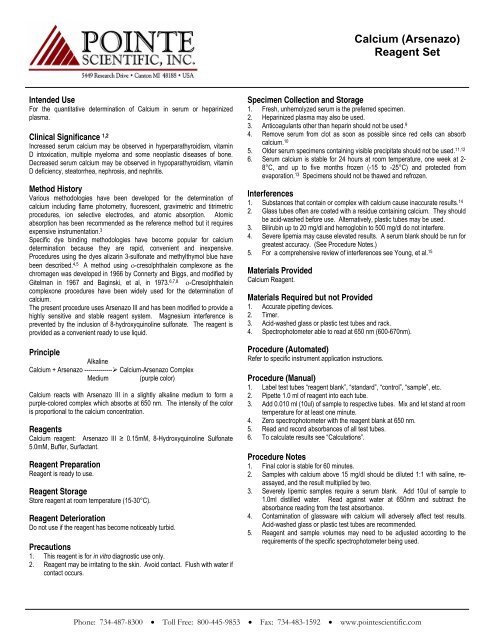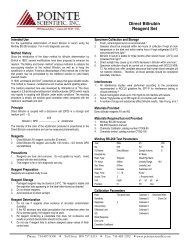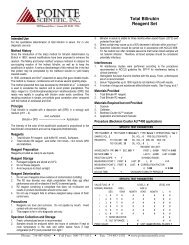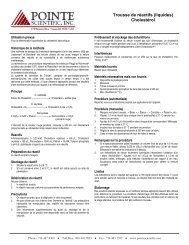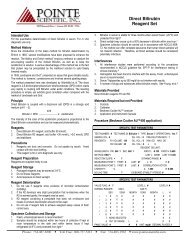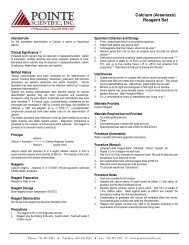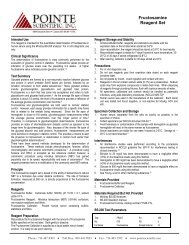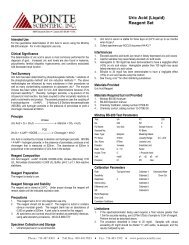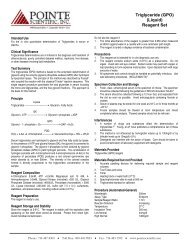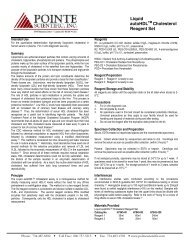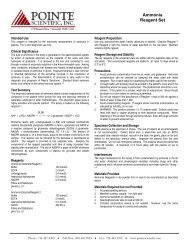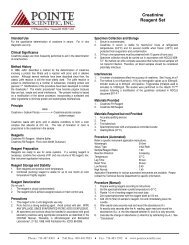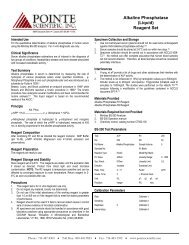Calcium (Arsenazo) Reagent Set - Pointe Scientific, Inc.
Calcium (Arsenazo) Reagent Set - Pointe Scientific, Inc.
Calcium (Arsenazo) Reagent Set - Pointe Scientific, Inc.
You also want an ePaper? Increase the reach of your titles
YUMPU automatically turns print PDFs into web optimized ePapers that Google loves.
Intended Use<br />
For the quantitative determination of <strong>Calcium</strong> in serum or heparinized<br />
plasma.<br />
Clinical Significance 1,2<br />
<strong>Inc</strong>reased serum calcium may be observed in hyperparathyroidism, vitamin<br />
D intoxication, multiple myeloma and some neoplastic diseases of bone.<br />
Decreased serum calcium may be observed in hypoparathyroidism, vitamin<br />
D deficiency, steatorrhea, nephrosis, and nephritis.<br />
Method History<br />
Various methodologies have been developed for the determination of<br />
calcium including flame photometry, fluorescent, gravimetric and titrimetric<br />
procedures, ion selective electrodes, and atomic absorption. Atomic<br />
absorption has been recommended as the reference method but it requires<br />
expensive instrumentation. 3<br />
Specific dye binding methodologies have become popular for calcium<br />
determination because they are rapid, convenient and inexpensive.<br />
Procedures using the dyes alizarin 3-sulfonate and methylthymol blue have<br />
been described. 4,5 A method using ο-cresolphthalein complexone as the<br />
chromagen was developed in 1966 by Connerty and Biggs, and modified by<br />
Gitelman in 1967 and Baginski, et al, in 1973. 6,7,8 ο-Cresolphthalein<br />
complexone procedures have been widely used for the determination of<br />
calcium.<br />
The present procedure uses <strong>Arsenazo</strong> III and has been modified to provide a<br />
highly sensitive and stable reagent system. Magnesium interference is<br />
prevented by the inclusion of 8-hydroxyquinoline sulfonate. The reagent is<br />
provided as a convenient ready to use liquid.<br />
Principle<br />
Alkaline<br />
<strong>Calcium</strong> + <strong>Arsenazo</strong> --------------� <strong>Calcium</strong>-<strong>Arsenazo</strong> Complex<br />
Medium (purple color)<br />
<strong>Calcium</strong> reacts with <strong>Arsenazo</strong> III in a slightly alkaline medium to form a<br />
purple-colored complex which absorbs at 650 nm. The intensity of the color<br />
is proportional to the calcium concentration.<br />
<strong>Reagent</strong>s<br />
<strong>Calcium</strong> reagent: <strong>Arsenazo</strong> III ≥ 0.15mM, 8-Hydroxyquinoline Sulfonate<br />
5.0mM, Buffer, Surfactant.<br />
<strong>Reagent</strong> Preparation<br />
<strong>Reagent</strong> is ready to use.<br />
<strong>Reagent</strong> Storage<br />
Store reagent at room temperature (15-30°C).<br />
<strong>Reagent</strong> Deterioration<br />
Do not use if the reagent has become noticeably turbid.<br />
Precautions<br />
1. This reagent is for in vitro diagnostic use only.<br />
2. <strong>Reagent</strong> may be irritating to the skin. Avoid contact. Flush with water if<br />
contact occurs.<br />
<strong>Calcium</strong> (<strong>Arsenazo</strong>)<br />
<strong>Reagent</strong> <strong>Set</strong><br />
Specimen Collection and Storage<br />
1. Fresh, unhemolyzed serum is the preferred specimen.<br />
2. Heparinized plasma may also be used.<br />
3. Anticoagulants other than heparin should not be used. 9<br />
4. Remove serum from clot as soon as possible since red cells can absorb<br />
calcium. 10<br />
5. Older serum specimens containing visible precipitate should not be used. 11,12<br />
6. Serum calcium is stable for 24 hours at room temperature, one week at 2-<br />
8°C, and up to five months frozen (-15 to -25°C) and protected from<br />
evaporation. 13 Specimens should not be thawed and refrozen.<br />
Interferences<br />
1. Substances that contain or complex with calcium cause inaccurate results. 14<br />
2. Glass tubes often are coated with a residue containing calcium. They should<br />
be acid-washed before use. Alternatively, plastic tubes may be used.<br />
3. Bilirubin up to 20 mg/dl and hemoglobin to 500 mg/dl do not interfere.<br />
4. Severe lipemia may cause elevated results. A serum blank should be run for<br />
greatest accuracy. (See Procedure Notes.)<br />
5. For a comprehensive review of interferences see Young, et al. 15<br />
Materials Provided<br />
<strong>Calcium</strong> <strong>Reagent</strong>.<br />
Materials Required but not Provided<br />
1. Accurate pipetting devices.<br />
2. Timer.<br />
3. Acid-washed glass or plastic test tubes and rack.<br />
4. Spectrophotometer able to read at 650 nm (600-670nm).<br />
Procedure (Automated)<br />
Refer to specific instrument application instructions.<br />
Procedure (Manual)<br />
1. Label test tubes “reagent blank”, “standard”, “control”, “sample”, etc.<br />
2. Pipette 1.0 ml of reagent into each tube.<br />
3. Add 0.010 ml (10ul) of sample to respective tubes. Mix and let stand at room<br />
temperature for at least one minute.<br />
4. Zero spectrophotometer with the reagent blank at 650 nm.<br />
5. Read and record absorbances of all test tubes.<br />
6. To calculate results see “Calculations”.<br />
Procedure Notes<br />
1. Final color is stable for 60 minutes.<br />
2. Samples with calcium above 15 mg/dl should be diluted 1:1 with saline, reassayed,<br />
and the result multiplied by two.<br />
3. Severely lipemic samples require a serum blank. Add 10ul of sample to<br />
1.0ml distilled water. Read against water at 650nm and subtract the<br />
absorbance reading from the test absorbance.<br />
4. Contamination of glassware with calcium will adversely affect test results.<br />
Acid-washed glass or plastic test tubes are recommended.<br />
5. <strong>Reagent</strong> and sample volumes may need to be adjusted according to the<br />
requirements of the specific spectrophotometer being used.<br />
Phone: 734-487-8300 • Toll Free: 800-445-9853 • Fax: 734-483-1592 • www.pointescientific.com
Limitations<br />
Samples with calcium values exceeding 15mg/dl 16 should be diluted with an<br />
equal volume of saline, the assay repeated, and the result multiplied by two.<br />
Severely lipemic samples should be run with a serum blank for greatest<br />
accuracy. See “Procedure Notes”.<br />
Calibration<br />
Use an aqueous <strong>Calcium</strong> Standard (10mg/dl) or an appropriate serum<br />
calibrator. The material used for calibration should be traceable to NIST<br />
material.<br />
Calculations<br />
Absorbance of sample x Concentration of Std. = <strong>Calcium</strong> (mg/dl)<br />
Absorbance of standard<br />
Example: If the absorbance of sample = 0.81, absorbance of standard =<br />
0.80, concentration of standard = 10mg/dl, then:<br />
0.81 x 10 = 10.1mg/dl<br />
0.80<br />
NOTE: To correct mg/dl to mEq/L, divide mg/dl value by two.<br />
Quality Control<br />
The integrity of the reaction should be monitored by use of normal and<br />
abnormal control sera with known calcium concentrations. These controls<br />
should be run at least with every working shift in which calcium assays are<br />
performed. It is recommended that each laboratory establish their own<br />
frequency of control determination.<br />
Expected Value<br />
Adults: 8.5-10.4 mg/dl 17<br />
Newborns: 7.8-11.2 mg/dl 18<br />
It is strongly recommended that each laboratory establish its own reference<br />
range.<br />
Performance<br />
1. Linearity: 0-15 mg/dl 16<br />
2. Comparison: A study performed with an ο-cresolphthalein complexone<br />
procedure yielded a correlation coefficient of 0.989 with a regression<br />
equation of y=0.99x + 0.10 (n=80, range=4.7-15.9 mg/dl).<br />
3. Precision:<br />
Within Run Run to Run<br />
Mean S.D. C.V.% Mean S.D. C.V.%<br />
11.0 0.14 1.3 11.2 0.12 1.1<br />
14.3 0.13 0.9 14.3 0.18 1.3<br />
4. Sensitivity: Recovery studies indicate that this reagent can distinguish<br />
calcium concentrations of 0.1 mg/dl throughout the linear range of the<br />
assay. 16<br />
<strong>Calcium</strong> (<strong>Arsenazo</strong>)<br />
<strong>Reagent</strong> <strong>Set</strong><br />
References<br />
1. Tietz, N.W., Fundamentals of Clinical Chemistry, Philadelphia, W.B.<br />
Saunders, p. 149 (1984).<br />
2. Henry, J.B., Clinical Diagnosis and Management by Laboratory Methods,<br />
Philadelphia, W.B. Saunders, p. 149 (1984).<br />
3. Cali, J.P., et al, N.B.S., Sp. Publication 260:36 (1972).<br />
4. Connerty, H.V. and Biggs, A.r., Am. J. Clin. Chem. 11:716 (1965).<br />
5. Gindler, E.M. and King, J.D., Am. J. Clin. Path. 58:376 (1972).<br />
6. Connerty, H.V. and Biggs, A.R., Am. J. Clin. Path. 45:290 (1966).<br />
7. Gitelman, H.J., Anal. Biochem. 18:521 (1967).<br />
8. Baginski, E.S., et al, Clin. Chem. Acta 46:49 (1973).<br />
9. Richterich, R., Clinical Chemistry: Theory and Practice, New York,<br />
Academic Press, p. 304 (1969).<br />
10. Peters, J.P., Van Slyke, D.D., Quantitative Clinical Chemistry – Vol. 2,<br />
Baltimore, Williams and Wilkins, (1932).<br />
11. Chen, P.S., et al, Anal. Chem. 26:1967 (1954).<br />
12. Tayeau, F., et al, Bull. Soc. Pharm. Bordeaux, 95:206 (1956).<br />
13. Henry, R.J., et al, Clinical Chemistry: Principles and Technics, Hagerstown<br />
(MD), Harper and Row, p. 669 (1974).<br />
14. Tietz, N.W., Fundamentals of Clinical Chemistry, Philadelphia, W.B.<br />
Saunders, pp. 903-904 (1984).<br />
15. Young, D.S., et al, Clin. Chem. 21:1D (1975).<br />
16. <strong>Pointe</strong> <strong>Scientific</strong> records.<br />
17. Tietz, N.W., Fundamentals of Clinical Chemistry, Philadelphia, W.B.<br />
Saunders, p. 1208 (1984).<br />
18. Meites, Samuel, Pediatric Clinical Chemistry, Washington DC, AACC Press,<br />
p. 81 (1989).<br />
Manufactured by <strong>Pointe</strong> <strong>Scientific</strong>, <strong>Inc</strong>.<br />
5449 Research Drive, Canton, MI 48188<br />
European Authorized Representative:<br />
Obelis s.a.<br />
Boulevard Général Wahis 53<br />
1030 Brussels, BELGIUM<br />
Tel: (32)2.732.59.54 Fax:(32)2.732.60.03 email: mail@obelis.net<br />
Rev. 12/09 P803-C7529-01


